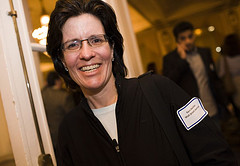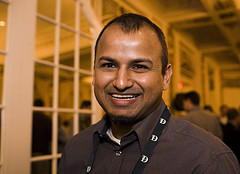
I attended the PaidContent San Francisco mixer event last night at the Palace Hotel, and was impressed with the packed house of 500 to 600 folks, from journalists to marketers to startup company executives. The room was buzzing, and brought back memories of the last dot-com boom in the ’90s when parties and mixers seemed to happen every night at exotic locales.
So I brought along an audio recorder and decided to survey the room, to find out whether people thought we were once again entering a speculative bubble with so many technology startups in social media, mobile marketing, mobile games, online video, and wikis. Most people responded by noting the differences between the first gung-ho bubble and this less pronounced one. This time, we don’t have IPOs (initial public offerings) creating ridiculous valuations for young companies, and the superstar companies such as Google, YouTube and MySpace are few and far between.
The following is a roundup of the more interesting and insightful answers I received from folks in the room, answering the simple question:
Do you think there’s a bubble again?
Tim, a bartender at the event:
No, there’s not a bubble. It’s not as crazy as it was in the bubble times. Back then, there was free champagne and free shots at the bar. Now it is a pay bar, and it’s much more orderly and serious. Before, they would come to us and ask how they could spend $100,000 on an event. That doesn’t happen now.
Staci Kramer, PaidContent executive editor:
You can’t say there’s a bubble across everything. A lot of things are being funded but they are being funded in more rational amounts, for the most part. You might see companies getting $100,000, $500,000 or $30,000 depending on what they’re doing. What you see is a lot of angel funding or bootstrapping. It’s not the numbers we were talking about before. The biggest question isn’t whether we have a bubble but whether people are creating companies or feature sets…It’s not as if Yahoo is standing on the corner buying every startup that walks by.
Another trend you’re seeing is companies buying a smaller percentage of startups rather than buying them out. In some cases, they buy a controlling interest but don’t buy a company. It may be because they want the technology. MTV has taken a stake in TagWorld, but they don’t want to buy the company, just the technology to use for themselves.
Eric Savitz, west coast editor at Barron’s:
It’s not a bubble like last time because it’s not the public’s money this time. There’s no Pets.com like before. Last time it had larger ripples in the investment community that hurt everyone. The Web 2.0 companies, if one dies in the forest, it won’t hurt anyone. If you start seeing online calendaring companies going public, then we’re in a bubble again.

Kara Swisher, producer of D: All Things Digital conference:
Yes, there is a bubble again. It’s not the same as before, but now people want to get bought by Google or Yahoo. It’s not a bubble where you’re selling your company to the poor, ignorant investing public. I guess it’s OK for it to be a bubble. Look around, this is ridiculous. But there’s no B-52’s, which I wish were here.
Stephen Burke, chief marketing officer, mbuzzy:
No. I think our industry is ovulating right now. I think we do things cheaper and faster than we did before. I think we’re in the early stages of absorbing all the capacity that was created with other people’s money 10 years ago. Mbuzzy is self-funded, and our key investors are a combination of former telecom and broadcast people. We’re a PC-to-mobile off-portal social network built around user-generated content. We have about 500,000 users we acquired for free.
It’s all [mergers and acquisitions], roll-ups so what you’ll see are roll-ups in mobile advertising and mobile user-generated content. The fact that so many people are doing it means that there is a good idea there, but not all of them can do it successfully.

Rafat Ali, PaidContent publisher and editor:
If you live in Silicon Valley, for sure; if you live outside, probably not. In the Valley you don’t look outside to what else is happening. There’s a bubble happening in some sectors, but there is real stuff happening in other sectors. What sectors have a bubble? In video, definitely.
Paul Smith, president of mPulse:
Let’s hope. Yeah, it would be a wonderful thing. It was a bubble [back then] but it created a lot of momentum in what would have been a slow and arduous process. I don’t think it was too fast, I think it was an appropriate exuberance. Yes, I think we’re seeing some signs of another bubble. People are having more fun. F-U-N, fun.
Scott Sutherland, SutherlandGold Group, PR
It doesn’t feel like a bubble again. There’s that kind of activity but it’s not the insane companies we saw before. I think there’s more money looking for good companies than there are good companies now. I still run into people who can’t get their companies funded now.
The mobile space is really hot, but the guys who are going alone, if you can’t partner with a carrier to help you market it, it’s very very difficult. The marketing budget is totally different now. I talked to a guy who got a site up and running for a couple hundred thousand dollars, and he’s driving traffic and selling advertising and he doesn’t need to raise $5 million, he wouldn’t want it. And then [a client of SutherlandGold] Brightcove has raised $80 million and there’s no venture funding in that at all — it’s all private equity. It’s an interesting dynamic on both sides of the equations.
The VCs [venture capitalists] are trying to reposition themselves so they can reach down with smaller investments. There’s a VC firm now that has a couple guys who are supposed to look for deals in the $250,000 to $500,000 range. With casual games, you can build a business around it without getting $5 million. You’re going to see a real splintering of that [VC] business. You won’t see those big rounds of investing. More capital will be spread around to more businesses.
John D. Villarreal, investment banker, former VC, former trainer for Mark McGwire
In terms of the Internet bubble, no. That was so bad. There were kids dropping out of college, 20 years old, getting $5 million, $10 million, $20 million. Before, you had VCs just throwing so much money and more money at things. Then you had the crash and VCs weren’t investing in anything. Those days are long gone and now we’re back to normal.
But there will always be bubbles. These VCs — and I’m friends with a lot of them, I love them — they’re sheep. People get myopic and get tunnel vision and only hear what they’re friends are saying and only read Red Herring. They read about Google and say ‘we need the next Google,’ or YouTube, ‘we need the next YouTube.’ Just like mobile gaming, it was big, but too many companies got funded too fast and now there’s a shakeout there. Instead of going for new technology or new things, they just wanted to pour money down the same things.
What do you think? Are we starting to see the beginning of another speculative bubble as in the ’90s or is this less frothy than previously? What signs do you see of a bubble or do you think those days are over? Share your thoughts in the comments below.
Photos by Lane Hartwell for Valleywag.
(To see more photos of the PaidContent event, go here.)

In Web 1.0, the term Bubble was used in the context of things being extremely overvalued. That isn’t necessarily the case right now – especially with so many start-ups bootstrapping their business instead of seeking VC funding. I think we’re at the beginning of what indeed may yield bubble 2.0 but for now, let the good times roll…that’s why Stowe Boyd and I started bub.blicio.us
I think this is not a bubble but serious and reasonable investing in a solid financial situration. I liked your pictures. so clear. did you use your cell phone to take them?
Ok, so because PE money is fueling the online video gold rush and not IPOs there is no bubble? This strikes me as a fallacious and/or self-serving argument.
PE groups are probably every bit as susceptible to the Silicon Valley PR echo chamber (in other words, to psychology) as retail investors. Furthermore, contrasting a superbubble (the 90s) with the present hardly serves as evidence that a bubble does not currently exist.